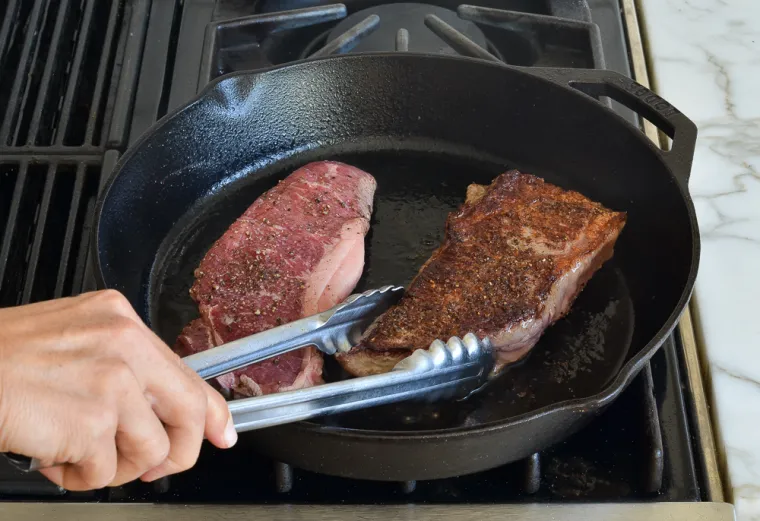
How To Make Steak On Hot Plate: Steps and Tips
Are you a steak enthusiast looking to elevate your culinary skills? Making a succulent steak on a hot plate is an art that combines technique and passion. In this comprehensive guide, we’ll take you through the step-by-step process of crafting the perfect steak on a hot plate. Whether you’re a seasoned grill master or a beginner, our tips and insights will help you achieve steak perfection every time.
How to Make Steak on a Hot Plate:
Preparing the Steak:
Before you dive into cooking, it’s essential to prepare your steak properly. Follow these steps for a mouthwatering result.
Choose the Right Cut: Begin with a high-quality cut of steak, such as ribeye, sirloin, or fillet. The marbling and fat content contribute to flavor and tenderness.
Seasoning: Generously season the steak with kosher salt and freshly ground black pepper. Allow the steak to sit at room temperature for about 30 minutes before cooking.
Optional Marinade: Consider marinating your steak with your favorite flavors – garlic, herbs, and olive oil, for example. This step adds an extra layer of taste.
Preparing the Hot Plate:
Heat the Hot Plate: Place the hot plate on your stovetop and heat it over medium-high heat. Ensure that the plate is evenly heated before placing the steak.
Oil the Plate: Lightly coat the hot plate with a high smoke point oil, such as canola or grapeseed oil. This prevents sticking and adds a nice sear to the steak.
Cooking the Steak:
Searing the Steak: Place the seasoned steak onto the hot plate. You should hear a sizzling sound as the steak makes contact. Allow it to sear for a few minutes on each side to develop a caramelized crust.
Internal Temperature: Use a meat thermometer to monitor the internal temperature. For rare, aim for 120°F (49°C), medium-rare 130°F (54°C), medium 140°F (60°C), and medium-well 150°F (65°C).
Resting Period: Once your steak reaches the desired temperature, remove it from the hot plate and let it rest for a few minutes. This allows the juices to redistribute and ensures a tender result.
Tips for a Perfect Steak:
Doneness: The hot plate offers precise control over the steak’s doneness. Experiment with cooking times to achieve your preferred level of doneness.
Searing Time: A longer searing time creates a richer crust, enhancing the overall flavor and texture.
Resting Time: Allowing the steak to rest is crucial for a juicy and flavorful outcome. Cover it with aluminum foil to retain heat during the resting period.
Achieving the Perfect Crust:
To achieve that sought-after crust on your hot plate steak, follow these steps:
Dry the Surface: Pat the steak dry with paper towels before seasoning. A dry surface promotes better searing.
High Heat: Ensure your hot plate is sufficiently heated before adding the steak. High heat is essential for a proper sear.
Avoid Crowding: Cook one or two steaks at a time to prevent overcrowding, which can lead to steaming rather than searing.
Common Mistakes to Avoid:
Skipping Resting Time: Rushing the resting period can result in a dry steak, as the juices won’t have time to redistribute.
Overcooking: Cooking the steak beyond your desired doneness can lead to a tough and less flavorful outcome.
Read more: Can You Use Parchment Paper On The Grill
FAQs:
Can I use a different type of oil for searing?
Absolutely! While canola and grapeseed oils are commonly used due to their high smoke points, you can experiment with other oils like avocado or sunflower oil.
How do I clean the hot plate after cooking?
Once the hot plate has cooled down, wipe it clean with a damp cloth. Avoid using harsh abrasives that could damage the surface.
Can I use a gas or electric hot plate?
Both gas and electric hot plates work well for cooking steak. Choose the type that suits your kitchen setup.
Should I pierce the steak to check for doneness?
Piercing the steak can cause precious juices to escape. It’s best to rely on a meat thermometer for an accurate doneness assessment.
Can I marinate the steak for an extended period?
Marinating for too long can lead to a mushy texture. Aim for a marinating time of 2 to 24 hours for the best results.
Can I reuse the leftover oil on the hot plate?
It’s recommended to use fresh oil for each cooking session to ensure optimal flavor and searing.
Conclusion
Mastering the art of making steak on a hot plate is a rewarding endeavor that allows you to savor restaurant-quality flavors in the comfort of your home. By following these steps and tips and avoiding common mistakes, you’ll be well on your way to becoming a steak connoisseur. So fire up that hot plate, select your favorite cut of steak, and embark on a culinary journey that promises mouthwatering results every time.